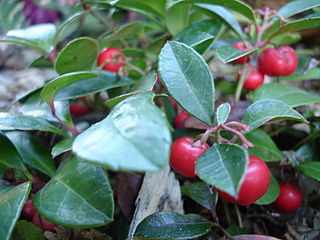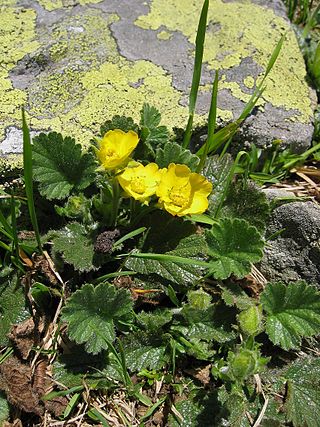
Rosaceae, the rose family, is a medium-sized family of flowering plants that includes 4,828 known species in 91 genera.

Rubus is a large and diverse genus of flowering plants in the rose family, Rosaceae, subfamily Rosoideae, with over 1,350 species.

Kalmia is a genus of about ten species of evergreen shrubs from 0.2–5 m tall, in the family Ericaceae. They are native to North America and Cuba. They grow in acidic soils, with different species in wet acid bog habitats and dry, sandy soils.

Gaultheria procumbens, also called the eastern teaberry, the checkerberry, the boxberry, or the American wintergreen, is a species of Gaultheria native to northeastern North America from Newfoundland west to southeastern Manitoba, and south to Alabama. It is a member of the Ericaceae.

Sir Robert Sibbald was a Scottish physician and antiquary.

Mespilus, commonly called medlar, is a monotypic genus of flowering plants in the family Rosaceae containing the single species Mespilus germanica of southwest Asia. It is also found in some countries in the Balkans, especially in Albanian regions. A second proposed species, Mespilus canescens, discovered in North America in 1990, proved to be a hybrid between M. germanica and one or more species of hawthorn, and is properly known as ×Crataemespilus canescens.

The Accursed Mountains, also known as the Albanian Alps, is a mountain range in coastal Southeast Europe adjected to the Adriatic Sea. It is the southernmost subrange of the 1,000-kilometre-long (621 mi) Dinaric Alps range (Dinarides), extending from northern Albania to southern Kosovo and northeastern Montenegro. Maja Jezercë, standing at 2,694 m (8,839 ft), is the highest point of the Accursed Mountains and of all Dinaric Alps, and the fifth highest peak in Albania. The range includes the mountain Zla Kolata, which, at 2,534 m (8,314 ft), is the tallest mountain in Montenegro. The range also includes the mountain Gjeravica, which, at 2,656 m (8,714 ft), is the second tallest mountain in Kosovo. One of the southernmost glacial masses in Europe was discovered in the Albanian part of the range in 2009.
NVC community CG10 is one of the calcicolous grassland communities in the British National Vegetation Classification system. Of the upland group of calcicolous grasslands, it is the only one with a short sward associated with heavy grazing.

Sibbaldiopsis is a genus in the plant family Rosaceae. This genus only contains a single species: Sibbaldiopsis tridentata, formerly Potentilla tridentata. Commonly, its names include three-toothed cinquefoil, shrubby fivefingers, and wineleaf. Systemic phylogenetic work has placed S. tridentata within Sibbaldia as Sibbaldia retusa.

Geum bulgaricum is a species of flowering plant of the genus Geum (avens) in the family Rosaceae. A perennial herbaceous plant, it has small, bell-like yellow flowers, and is native to a few mountains on the Balkan Peninsula.

Galinsoga quadriradiata is a species of flowering plant in the family Asteraceae which is known by several common names, including shaggy soldier, Peruvian daisy, hairy galinsoga. Its native home is apparently central Mexico, although it has become naturalized in many other places.

Sibbaldia procumbens is a species of flowering plant of the genus Sibbaldia in the rose family. It has an Arctic–alpine distribution; it can be found throughout the Arctic, as well as at higher elevations in the mountains of Eurasia and North America. It grows on tundra and in alpine climates where snow remains year-round, and on subalpine mountain slopes. This is a low, mat-forming perennial herb producing clumps of herbage in rocky, gravelly substrate. A spreading stem up to 15 centimeters long grows from a caudex. Each leaf is divided into usually three leaflets borne at the end of a petiole up to 7 centimeters long. Each wedge-shaped leaflet has three teeth at the tip. The flower has usually five pointed green bractlets, five wider pointed green sepals, and five tiny yellowish petals each about a millimeter long. The fruits develop in the remnants of the sepals on erect stalks.

Geum coccineum is a species of flowering plant in the genus Geum, in the rose family Rosaceae. Native to the mountains of the Balkans and northern Turkey, it is also grown ornamentally for its bright red flowers.

Geum montanum, the Alpine avens, is a species of flowering plant of the genus Geum in the Rosaceae family, native to the mountains of central and southern Europe.

The flora of the U.S. Sierra Nevada alpine zone is characterized by small, low growing, cushion and mat forming plants that can survive the harsh conditions in the high-altitude alpine zone above the timber line. These flora often occur in alpine fell-fields. The Sierra Nevada alpine zone lacks a dominant plant species that characterizes it, so may or may not be called a vegetation type. But it is found above the subalpine forest, which is the highest in a succession of recognized vegetation types at increasing elevations.

For a small country, Albania is characterised by a considerable wealth of terrestrial and marine ecosystems and habitats with contrasting floral, faunal, and fungal species, defined in an area of 28,748 square kilometres. Most of the country is predominantly of Mediterranean character, comprehending the country's center and south, while the alpine affinity is more visible in the northeast.

Yulen is a nature reserve in Pirin National Park, located in the homonymous mountain range in south-western Bulgaria. It is situated in Bansko Municipality, Blagoevgrad Province. Yulen was declared on 26 August 1994 to monitor the growth of alpine plant species without human influence, as well as to protect rare plant and animal species. It spans a territory of 3156 ha or 31.56 km2.

The wildlife of Greece includes the diverse flora, fauna, and funga of Greece, a country in southern Europe. The country is mostly mountainous with a very long, convoluted coastline, consisting of peninsulas and many islands. The climate ranges from Mediterranean through temperate to alpine, and the habitats include mountains, hills, forests, rivers, lakes, coasts and cultivated land.

Sibbaldia is a genus of flowering plants of the family Rosaceae, with a circumpolar distribution, including the high Arctic. Most of the species are found in the Himalaya. The type species is Sibbaldia procumbens. It is also in the Rosoideae subfamily.
Geum molle is a species of flowering plant of the genus Geum (avens) in the family Rosaceae. A perennial herbaceous plant found on meadows, it is native to the mountains of the Balkan Peninsula and Italy. It blooms with yellow flowers between June and August.

















